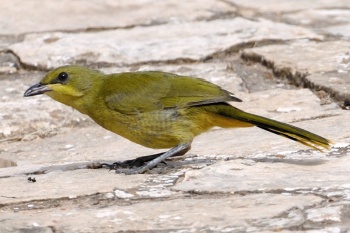- Telophorus zeylonus
Identification
22–24 cm (8½-9½ in), mass 48-76 g
- Grey crown and nape
- Olive-green back and upper wing coverts
- Yellow eyebrow, chin and throat
- Black gorget and throat border
- Yellow belly
Males and females are alike.
Distribution
Southern Africa: South Africa, Lesotho, eSwatini, southern and north-western Namibia, coastal south-western Angola, extreme southern Botswana. There is an isolated population in the Chimanimani Mountains on the border of Zimbabwe and Mozambique.
Taxonomy
Subspecies
There are four subspecies [1]:
- T. z. zeylonus: South Africa (except for the north-west), Lesotho and eSwatini;
- T. z. thermophilus: north-western South Africa, Namibia south of 21°S, and extreme southern Botswana. [Paler than nominate;]
- T. z. phanus: north-western Namibia and coastal Angola south of Benguela. [paler and has a stouter bill than T. z. thermophilus.]
- T. z. restrictus: the Chimanimani Mountains [darker above than nominate, with greyer flanks and a broader black gorget.]
Habitat
Shrubland (karoo and fynbos), grassland with scattered shrubs, gardens.
Behaviour
Usually in pairs or groups of three.
Breeding
Monogamous and territorial. The nest is a compact cup using a variety of fine plant material, usually well concealed and within 6 m of the ground. Two to five eggs are laid year round, but mostly July to October.
Diet
Forages mainly on the ground, close to cover, for invertebrates (grasshoppers, stick insects etc), reptiles, amphibians, small birds and fruit.
References
- Clements, J. F., T. S. Schulenberg, M. J. Iliff, D. Roberson, T. A. Fredericks, B. L. Sullivan, and C. L. Wood. 2017. The eBird/Clements checklist of birds of the world: v2017, with updates to August 2017. Downloaded from http://www.birds.cornell.edu/clementschecklist/download/
- Hockey, PAR, WRJ Dean, and PG Ryan, eds. 2005. Roberts' Birds of Southern Africa. 7th ed. Cape Town: John Voelcker Bird Book Fund. ISBN 978-0620340533
- Handbook of the Birds of the World Alive (retrieved November 2014)
Recommended Citation
- BirdForum Opus contributors. (2025) Bokmakierie. In: BirdForum, the forum for wild birds and birding. Retrieved 13 May 2025 from https://www.birdforum.net/opus/Bokmakierie
External Links
GSearch checked for 2020 platform.1





